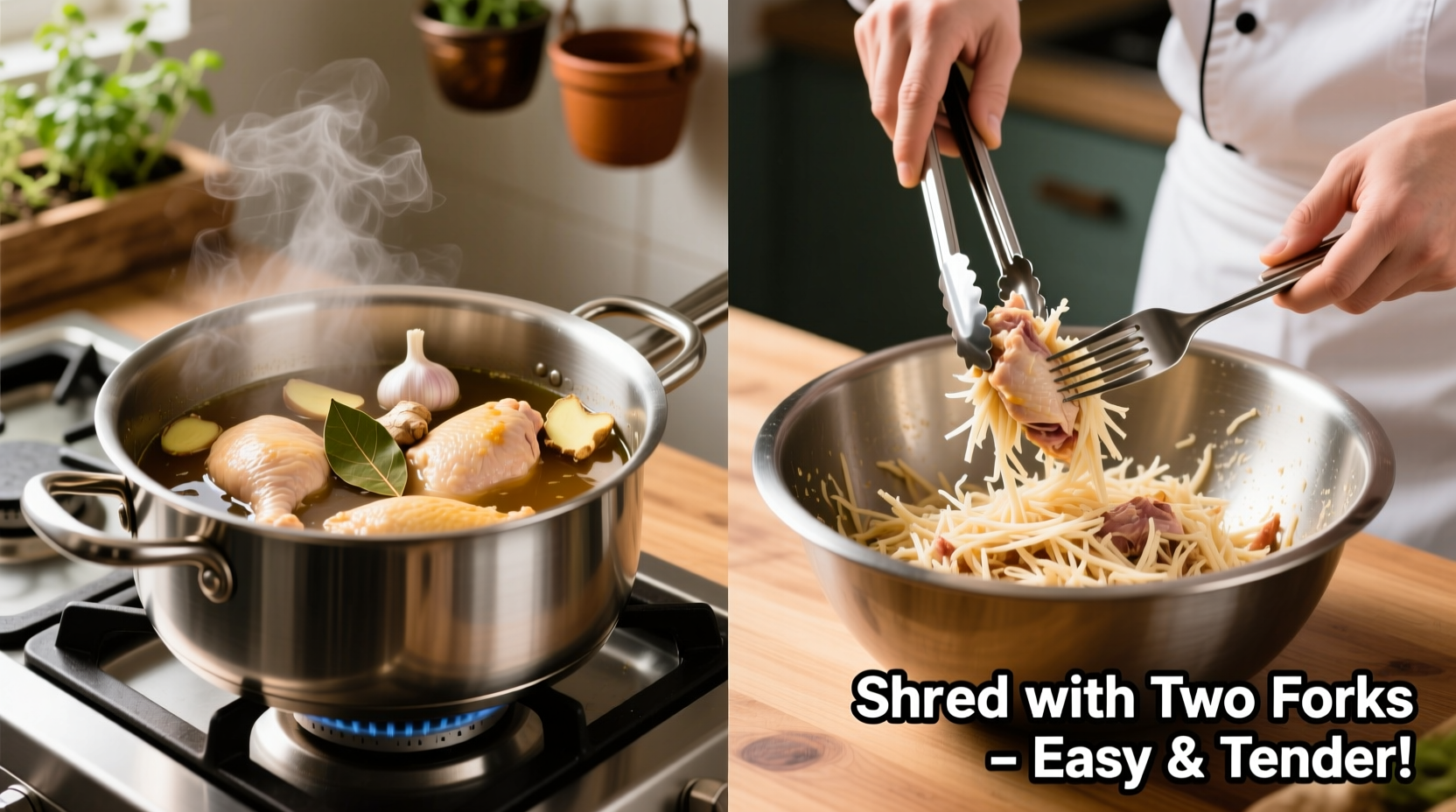Why Poaching Creates Perfect Shredded Chicken
Understanding the science behind tender shredded chicken helps you avoid common pitfalls. When chicken reaches 160-170°F, its muscle fibers contract and expel moisture. Poaching in flavorful liquid at a controlled temperature (160-180°F) prevents the violent boiling that makes chicken tough. The USDA Food Safety and Inspection Service confirms that poultry is safe to eat at 165°F internal temperature, but removing it from heat at 160°F allows carryover cooking to reach the safe temperature while preserving juiciness (USDA FSIS).
Your Step-by-Step Path to Perfect Shredded Chicken
Preparation: Setting Up for Success
Before cooking, gather these essentials:
- 1.5-2 lbs boneless, skinless chicken breasts or thighs (thighs stay moister)
- 4 cups low-sodium chicken broth (or water with 2 tsp salt)
- Aromatics: 1 onion quartered, 2 garlic cloves, 2 bay leaves
- Acid component: 1 lemon wedge or 2 tbsp apple cider vinegar
- Instant-read thermometer (critical for perfect results)
| Cooking Method | Time Required | Texture Result | Best For |
|---|---|---|---|
| Stovetop Poaching | 20 minutes | Most tender, uniform texture | Tacos, salads, sandwiches |
| Slow Cooker | 3-4 hours | Very tender, slightly stringier | Soups, casseroles |
| Oven Baking | 25 minutes | Firmer texture, less moist | Dishes needing structure |
Cooking: The Foolproof Poaching Method
This professional technique guarantees shreddable chicken every time:
- Place chicken in a single layer in a large pot
- Add broth and aromatics (avoid overcrowding)
- Bring to a gentle simmer (small bubbles breaking surface)
- Cover and cook 12-15 minutes for breasts, 15-18 for thighs
- Remove chicken when internal temperature hits 160°F
- Rest 5 minutes in cooking liquid before shredding

Shredding: Getting That Perfect Texture
Timing matters most here. Shred immediately after resting while chicken is still warm:
- Use two forks held back-to-back to pull meat apart
- Work with one piece at a time for uniform shreds
- Add 2-3 tbsp cooking liquid to maintain moisture
- For finer shreds, use hand mixer on low speed for 15 seconds
Avoid These 3 Shredding Failures
Even with perfect cooking, these mistakes ruin texture:
- Overcooking by just 5 minutes - Turns chicken dry and stringy rather than tender
- Skipping the rest period - Causes juices to escape when shredding
- Using cold chicken - Makes fibers tighten and resist shredding
Storage: Keeping Your Shredded Chicken Fresh
Proper storage maintains quality and safety:
- Refrigerate in airtight container with 2-3 tbsp cooking liquid
- Consume within 3-4 days (USDA recommends 3-4 days for cooked poultry)
- Freeze in portion-sized bags for up to 4 months
- Thaw overnight in refrigerator, not at room temperature
Flavor Boosters for Versatile Shredded Chicken
Elevate your basic shredded chicken for different cuisines:
- Mexican style: Add 1 tsp cumin, 1/2 tsp smoked paprika, and lime zest during cooking
- Asian inspired: Simmer with 2 tbsp soy sauce, 1 tbsp ginger, and star anise
- BBQ ready: Toss shredded chicken with 1/4 cup apple cider vinegar before adding sauce
When to Choose Thighs Over Breasts
While chicken breasts are popular, thighs offer advantages for shredding:
- Higher fat content (10% vs 3% in breasts) maintains moisture during cooking
- More connective tissue breaks down into gelatin for tender texture
- Withstands longer cooking times needed for certain recipes
- Ideal for soups and stews where chicken needs to hold up











 浙公网安备
33010002000092号
浙公网安备
33010002000092号 浙B2-20120091-4
浙B2-20120091-4